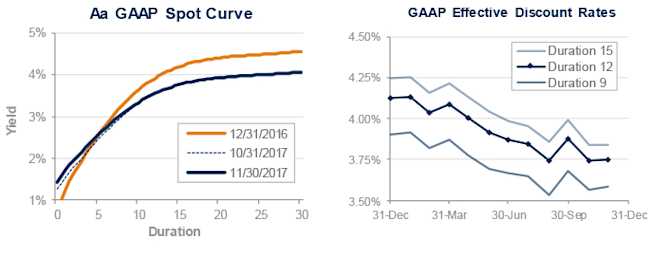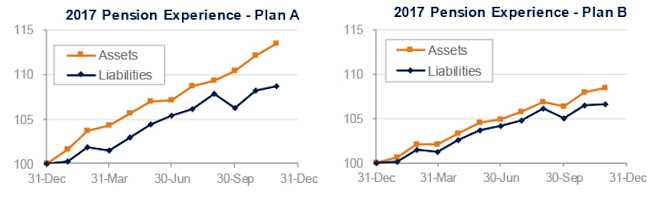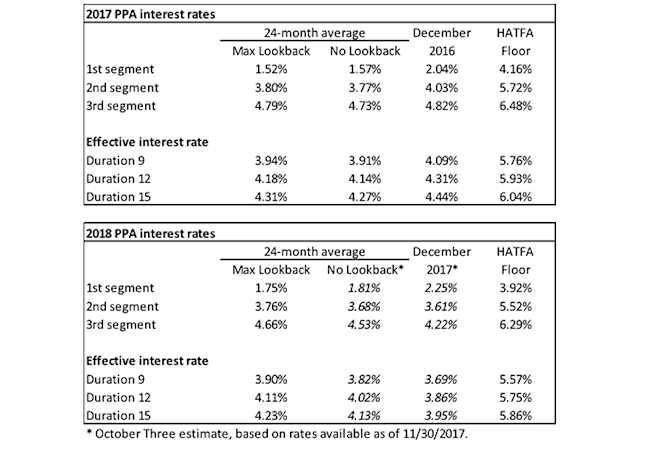
November 2017 Pension Finance Update
Stock markets brought more good news to pension sponsors in November, with a continuation of the remarkably steady bull market of 2017. Both model plans we track1 saw improvement in funded status last month: traditional Plan A improved 1% and is now up almost 5% for the year, while the more conservative Plan B improved a fraction of 1% in November ahead almost 2% through the first eleven months of 2017.

Assets
Stocks gained across the board again last month: the S&P 500 gained 2%, the NASDAQ jumped 3%, the small-cap Russell 2000 added 3%, and the overseas EAFE index was up almost 1%. Through November, the Russell 2000 is ahead 15%, the S&P 500 is up 20%, the EAFE has gained 23%, and the NASDAQ has earned almost 28%.
A diversified stock portfolio gained more than 2% during November and is now up 22% through the first eleven months of 2017.
Bonds of all flavors were close to flat in November, as interest rates edged up a few basis points and credit spreads remained at their tightest level in years. A diversified bond portfolio has earned 4%-7% so far during 2017, with longer duration bonds and corporates doing best.
Overall, our traditional 60/40 portfolio gained 1% in November is now up 13% for the year, while the conservative 20/80 portfolio gained less than 1% last month and is now more 8% ahead during 2017.
Liabilities
Pension liabilities (for funding, accounting, and de-risking purposes) are now driven by market interest rates. The graph on the left compares our Aa GAAP spot yield curve at December 31, 2016, and November 30, 2017, and it also shows the (small) movement in the curve last month. The graph on the right shows our estimate of movements in effective GAAP discount rates for pension obligations of various durations during 2017:

Long-term rates edged up just a bit during November.
The move held pension liabilities steady during the month, leaving liabilities 6%-9% higher during 2017, with long duration plans seeing the biggest increases.
Summary
2017 has been a year of surprises. The bull market in stocks was already long in the tooth coming into the year, and few anticipated 20% returns this year. At the same time, long-term interest rates continue to flirt with all-time lows, pushing pension liabilities up.
On net, the experience this year has been positive for most pension sponsors.
The graphs below show the movement of assets and liabilities for our two model plans during the first eleven months of 2017:

Looking Ahead
Congress passed a budget in 2015 that includes a third round of pension funding relief since 2012. The upshot is that pension funding requirements over the next few years will not be appreciably affected by current low interest rates (unless these rates persist). Required contributions for the next few years will be lower and more stable than under prior law.
Discount rates moved up a couple basis points last month. We expect most pension sponsors will use effective discount rates in the 3.6%-4.0% range to measure pension liabilities right now. As things stand, employers with calendar year financial statements will be looking at the lowest rates ever for measuring liabilities at the end of 2017.
The table below summarizes rates that plan sponsors are required to use for IRS funding purposes for 2017, along with estimates for 2018. Pre-relief, both 24-month averages and December ‘spot’ rates, which are still required for some calculations, such as PBGC premiums, are also included.

1Plan A is a traditional plan (duration 12 at 5.5%) with a 60/40 asset allocation, while Plan B is a cash balance plan (duration 9 at 5.5%) with a 20/80 allocation with a greater emphasis on corporate and long-duration bonds. We assume overhead expenses of 1% of plan assets per year, and we assume the plans are 100% funded at the beginning of the year and ignore benefit accruals, contributions, and benefit payments in order to isolate the financial performance of plan assets versus liabilities.
